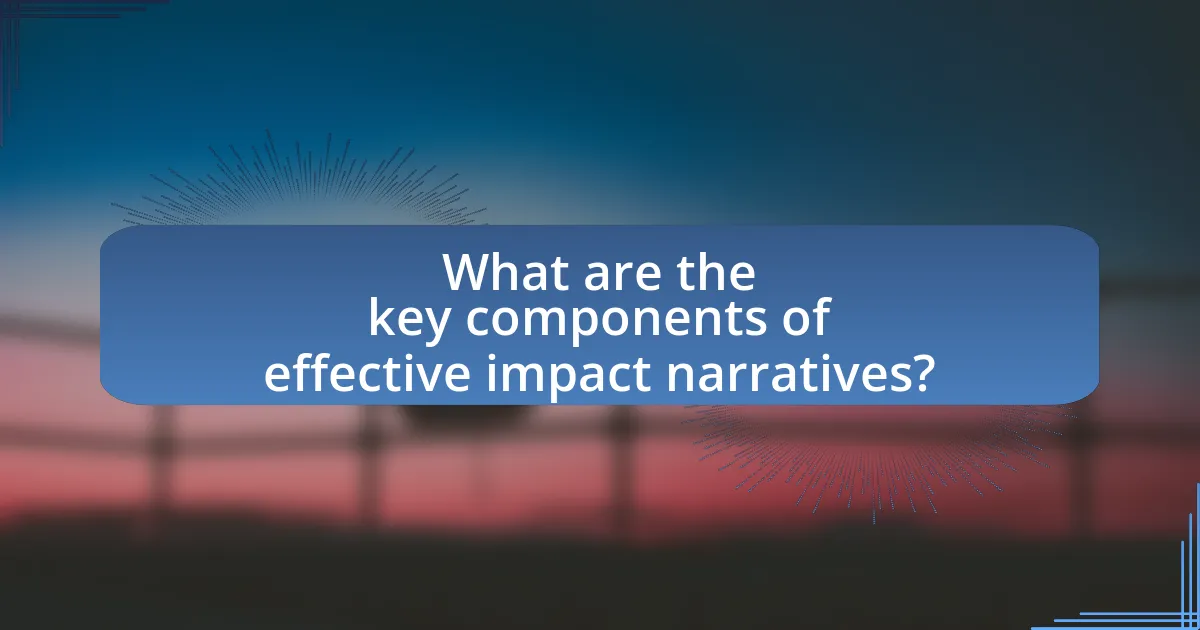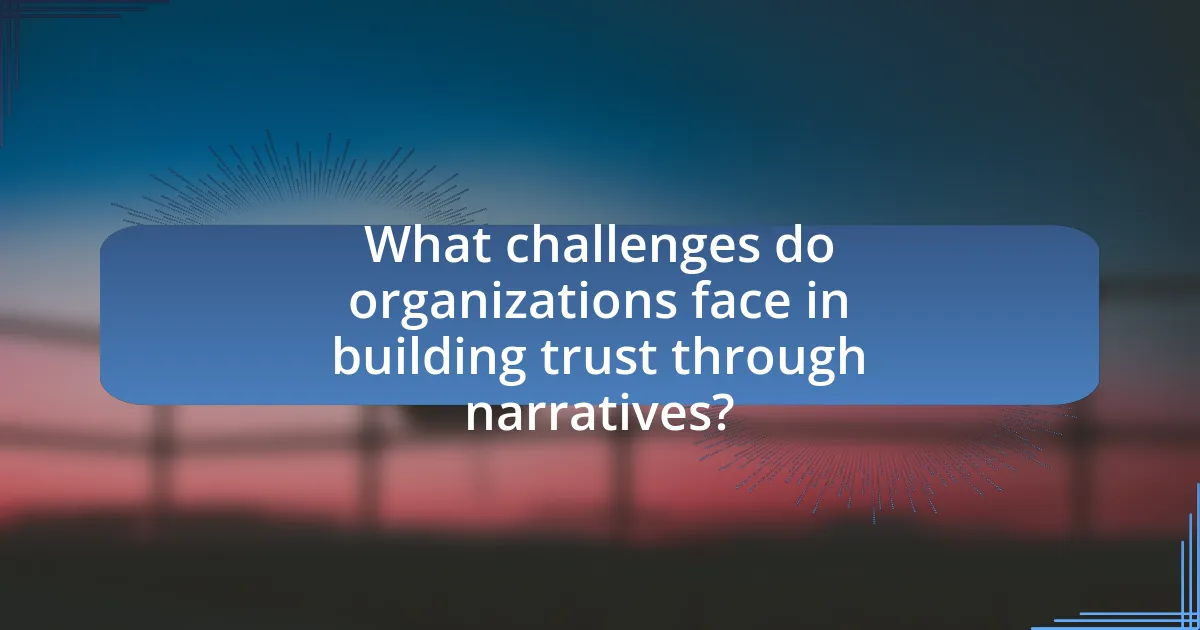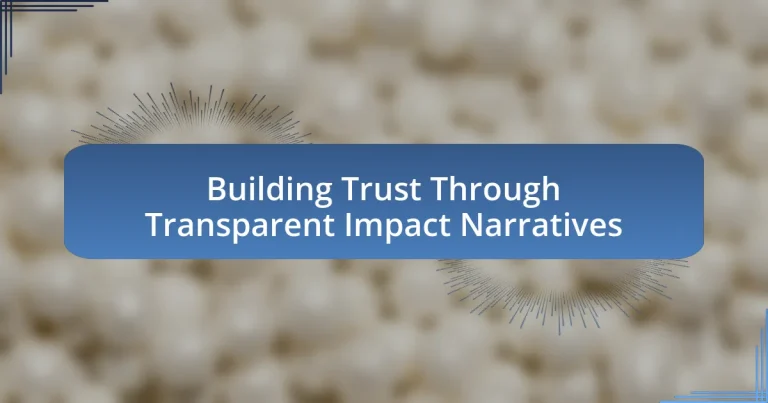Building trust through transparent impact narratives is a critical practice for organizations seeking to enhance credibility and stakeholder engagement. This article outlines how clear, honest, and accessible accounts of an organization’s activities and outcomes foster accountability and reduce uncertainty. Key components of effective impact narratives include clarity, emotional resonance, evidence-based outcomes, and stakeholder engagement. The article also discusses the importance of transparency in shaping stakeholder perceptions, the consequences of a lack of trust, and practical steps organizations can take to craft compelling narratives that resonate with diverse audiences. Additionally, it highlights the role of data integration, audience tailoring, and feedback mechanisms in improving narrative effectiveness and maintaining trust.

What is Building Trust Through Transparent Impact Narratives?
Building trust through transparent impact narratives involves creating clear, honest, and accessible accounts of an organization’s activities and their outcomes. This practice fosters credibility and accountability, as stakeholders can see the direct effects of initiatives and understand how resources are utilized. Research indicates that organizations that share detailed impact narratives experience higher levels of stakeholder engagement and trust, as transparency reduces uncertainty and builds confidence in the organization’s mission and effectiveness.
How do transparent impact narratives contribute to trust-building?
Transparent impact narratives contribute to trust-building by providing clear, honest, and detailed accounts of actions and outcomes. These narratives allow stakeholders to understand the motivations, processes, and results of initiatives, fostering a sense of accountability. For instance, organizations that share specific data on their social or environmental impacts, such as reductions in carbon emissions or improvements in community well-being, demonstrate their commitment to transparency. This openness not only enhances credibility but also encourages stakeholder engagement, as individuals feel more informed and involved in the organization’s mission. Research shows that transparency in communication correlates with increased trust levels; a study by the Harvard Business Review found that organizations perceived as transparent are more likely to gain stakeholder loyalty and support.
What elements make an impact narrative transparent?
An impact narrative is transparent when it includes clear data, specific outcomes, and stakeholder voices. Clear data provides measurable evidence of impact, allowing audiences to understand the effectiveness of initiatives. Specific outcomes detail the tangible results achieved, making it easier for stakeholders to assess success. Including stakeholder voices, such as testimonials or case studies, adds authenticity and personal connection, reinforcing the narrative’s credibility. These elements collectively enhance transparency by ensuring that the narrative is grounded in factual information and real experiences, fostering trust among audiences.
How does transparency influence stakeholder perceptions?
Transparency significantly enhances stakeholder perceptions by fostering trust and credibility. When organizations openly share information regarding their operations, decision-making processes, and impacts, stakeholders feel more informed and engaged. This openness reduces uncertainty and builds confidence in the organization’s integrity. Research indicates that companies with high transparency levels often experience improved stakeholder relationships, as evidenced by a 2020 study published in the Journal of Business Ethics, which found that transparent communication positively correlates with stakeholder trust and satisfaction. Thus, transparency serves as a critical factor in shaping favorable stakeholder perceptions.
Why is trust important in organizational contexts?
Trust is crucial in organizational contexts because it fosters collaboration, enhances communication, and drives employee engagement. When trust exists, team members are more likely to share ideas, take risks, and work towards common goals, leading to increased productivity and innovation. Research indicates that organizations with high trust levels experience 50% higher employee engagement and 40% lower turnover rates, demonstrating that trust directly impacts organizational performance and stability.
What are the consequences of a lack of trust?
A lack of trust leads to decreased collaboration and increased conflict among individuals and organizations. When trust is absent, communication breaks down, resulting in misunderstandings and inefficiencies. Research indicates that organizations with low trust levels experience a 50% decrease in productivity and a 40% increase in employee turnover, as employees feel less engaged and more likely to leave. Furthermore, a lack of trust can damage reputations, making it difficult for entities to attract partners or customers, ultimately impacting financial performance.
How does trust affect stakeholder engagement?
Trust significantly enhances stakeholder engagement by fostering open communication and collaboration. When stakeholders perceive an organization as trustworthy, they are more likely to participate actively, share valuable insights, and support initiatives. Research indicates that organizations with high trust levels experience increased stakeholder loyalty and commitment, leading to better project outcomes. For instance, a study by the Institute for Public Relations found that trust in leadership correlates with employee engagement, which in turn affects overall organizational performance. Thus, trust serves as a critical foundation for effective stakeholder engagement.

What are the key components of effective impact narratives?
The key components of effective impact narratives include clarity, emotional resonance, evidence-based outcomes, and stakeholder engagement. Clarity ensures that the message is easily understood, allowing the audience to grasp the significance of the impact being communicated. Emotional resonance connects with the audience on a personal level, making the narrative relatable and compelling. Evidence-based outcomes provide concrete data and examples that validate the claims made in the narrative, enhancing credibility. Stakeholder engagement involves incorporating the voices and experiences of those affected by the impact, fostering a sense of community and trust. These components work together to create a narrative that is not only informative but also trustworthy and impactful.
How can organizations craft compelling impact narratives?
Organizations can craft compelling impact narratives by clearly articulating their mission, demonstrating measurable outcomes, and sharing authentic stories from beneficiaries. A well-defined mission provides a foundation that aligns the narrative with the organization’s goals, while measurable outcomes, such as statistics on program effectiveness, lend credibility and demonstrate tangible impact. Authentic stories from beneficiaries humanize the data, making the narrative relatable and emotionally engaging. For instance, a nonprofit that reports a 30% increase in community health outcomes alongside testimonials from individuals who benefited from its programs effectively combines quantitative and qualitative evidence to enhance its narrative.
What storytelling techniques enhance impact narratives?
Effective storytelling techniques that enhance impact narratives include the use of emotional appeal, relatable characters, and a clear structure. Emotional appeal engages the audience’s feelings, making the narrative more memorable and persuasive; for instance, narratives that evoke empathy can significantly increase audience connection and response. Relatable characters allow the audience to see themselves in the story, fostering a deeper understanding of the impact being conveyed. A clear structure, often following a beginning, middle, and end format, helps to organize the narrative, making it easier for the audience to follow and retain the message. Research indicates that narratives with these techniques can lead to higher engagement rates and greater trust in the message being communicated.
How can data be effectively integrated into narratives?
Data can be effectively integrated into narratives by using clear visualizations, contextual storytelling, and relatable examples. Clear visualizations, such as graphs and charts, help to present complex data in an easily digestible format, allowing audiences to grasp key insights quickly. Contextual storytelling connects data points to real-world scenarios, making the information more relevant and engaging for the audience. Relatable examples, such as case studies or personal anecdotes, further humanize the data, fostering emotional connections and enhancing understanding. Research shows that narratives that combine data with storytelling techniques can increase retention and comprehension, as evidenced by a study published in the journal “Science” by researchers at the University of California, which found that stories can improve memory recall of statistical information by up to 20%.
What role does audience play in shaping impact narratives?
The audience plays a crucial role in shaping impact narratives by influencing the content, tone, and delivery of the message. Their values, beliefs, and expectations dictate how narratives are constructed to resonate effectively, ensuring that the intended impact is achieved. For instance, research by the Stanford Social Innovation Review highlights that organizations that tailor their narratives to align with audience interests see a 30% increase in engagement and trust. This demonstrates that understanding the audience’s perspective is essential for creating compelling and trustworthy impact narratives.
How can organizations tailor narratives for different stakeholders?
Organizations can tailor narratives for different stakeholders by understanding their unique interests, values, and concerns. This involves conducting stakeholder analysis to identify key demographics and motivations, allowing organizations to craft messages that resonate specifically with each group. For example, investors may prioritize financial performance and sustainability metrics, while customers might focus on product quality and ethical sourcing. Research indicates that personalized communication increases engagement; a study by the Harvard Business Review found that tailored messaging can improve stakeholder trust and loyalty by up to 30%. By aligning narratives with stakeholder expectations, organizations can effectively build trust and foster stronger relationships.
What feedback mechanisms can improve narrative effectiveness?
Feedback mechanisms that can improve narrative effectiveness include audience surveys, focus groups, and iterative testing. Audience surveys provide direct insights into how well the narrative resonates with the target demographic, allowing for adjustments based on specific feedback. Focus groups facilitate in-depth discussions that reveal emotional responses and comprehension levels, which can guide narrative refinement. Iterative testing, where narratives are presented in stages and modified based on real-time reactions, ensures that the final product aligns closely with audience expectations. Research indicates that narratives that are continuously refined through these mechanisms tend to engage audiences more effectively, as evidenced by studies showing increased retention and emotional connection when narratives are tailored to audience feedback.

What challenges do organizations face in building trust through narratives?
Organizations face several challenges in building trust through narratives, primarily including authenticity, consistency, and audience engagement. Authenticity is crucial; if narratives are perceived as insincere or exaggerated, trust diminishes. For instance, a study by the Edelman Trust Barometer indicates that 81% of consumers need to trust a brand before purchasing, highlighting the importance of genuine storytelling. Consistency across various platforms and communications is also vital; discrepancies can lead to skepticism. Furthermore, engaging the audience effectively poses a challenge, as narratives must resonate with diverse demographics to foster connection and trust. Research shows that 70% of consumers prefer brands that tell stories they can relate to, underscoring the need for tailored narratives.
How can organizations overcome skepticism towards impact narratives?
Organizations can overcome skepticism towards impact narratives by prioritizing transparency and providing verifiable evidence of their claims. Transparency involves openly sharing data, methodologies, and outcomes related to their initiatives, which allows stakeholders to assess the credibility of the narratives. For instance, organizations can publish detailed reports that include metrics and case studies demonstrating the actual impact of their programs. Research indicates that 70% of consumers are more likely to trust brands that are transparent about their practices (Edelman Trust Barometer, 2021). By consistently delivering factual, accessible information and engaging with stakeholders to address concerns, organizations can build trust and reduce skepticism surrounding their impact narratives.
What strategies can mitigate misinformation and distrust?
To mitigate misinformation and distrust, organizations should implement strategies such as promoting media literacy, ensuring transparency in communication, and fostering community engagement. Media literacy programs educate individuals on how to critically evaluate information sources, which reduces susceptibility to false narratives. Transparency in communication involves sharing clear, factual information and disclosing potential biases, thereby building credibility. Community engagement initiatives, such as open forums and discussions, allow for direct dialogue between organizations and the public, which can address concerns and clarify misunderstandings. Research indicates that these strategies collectively enhance trust and reduce the spread of misinformation, as evidenced by studies showing that informed communities are less likely to believe in false information.
How can organizations address past failures in transparency?
Organizations can address past failures in transparency by implementing clear communication strategies and establishing accountability measures. By openly acknowledging previous shortcomings, organizations can rebuild trust with stakeholders. For instance, a study by the Harvard Business Review highlights that companies that admit mistakes and provide detailed explanations of corrective actions see a 30% increase in stakeholder trust. Additionally, organizations can create regular transparency reports that outline progress and setbacks, ensuring stakeholders are informed and engaged in the process. This proactive approach not only demonstrates commitment to transparency but also fosters a culture of openness and continuous improvement.
What are the best practices for maintaining transparency in impact narratives?
The best practices for maintaining transparency in impact narratives include clear communication, consistent reporting, and stakeholder engagement. Clear communication involves articulating goals, methods, and outcomes in straightforward language, ensuring that the audience understands the narrative. Consistent reporting requires regular updates on progress and challenges, which fosters trust and accountability. Stakeholder engagement emphasizes involving affected communities and partners in the narrative process, allowing for diverse perspectives and feedback. These practices are supported by research indicating that organizations demonstrating transparency are more likely to build trust and credibility with their audiences, as evidenced by a study from the Stanford Social Innovation Review, which highlights the correlation between transparency and stakeholder trust.
How often should organizations update their narratives?
Organizations should update their narratives at least annually or whenever significant changes occur within the organization or its environment. Regular updates ensure that narratives remain relevant and reflect the current mission, values, and impact of the organization. For instance, a study by the Stanford Social Innovation Review emphasizes that organizations that adapt their narratives in response to stakeholder feedback and changing circumstances are more likely to maintain trust and engagement with their audiences.
What tools can assist in tracking and reporting impact effectively?
Tools that can assist in tracking and reporting impact effectively include data management software, impact measurement frameworks, and analytics platforms. Data management software like Salesforce or Airtable enables organizations to collect and organize data systematically, facilitating easier tracking of impact metrics. Impact measurement frameworks such as the Logic Model or Theory of Change provide structured approaches to define, measure, and report on outcomes, ensuring that organizations can communicate their impact clearly. Analytics platforms like Tableau or Google Data Studio allow for the visualization of data, making it easier to interpret and share findings with stakeholders. These tools collectively enhance transparency and accountability in impact reporting, fostering trust among stakeholders.
What practical steps can organizations take to enhance trust through narratives?
Organizations can enhance trust through narratives by implementing transparent communication strategies that clearly articulate their values, missions, and impacts. By sharing authentic stories that highlight real experiences and outcomes, organizations can foster a deeper connection with their audience. For instance, using data-driven evidence to support claims about social or environmental impacts can significantly bolster credibility. Research indicates that 70% of consumers are more likely to trust a brand that shares its story transparently, as seen in the 2021 Edelman Trust Barometer. Additionally, engaging stakeholders in the narrative process, such as featuring testimonials from beneficiaries or employees, can further humanize the organization and build trust.
How can organizations engage stakeholders in narrative development?
Organizations can engage stakeholders in narrative development by actively involving them in the storytelling process through workshops, interviews, and feedback sessions. This collaborative approach ensures that diverse perspectives are integrated, fostering a sense of ownership among stakeholders. Research indicates that organizations that include stakeholders in narrative creation enhance trust and transparency, as evidenced by a study published in the Journal of Business Ethics, which found that stakeholder involvement in decision-making processes leads to increased organizational credibility and stakeholder satisfaction.
What metrics can be used to measure the effectiveness of impact narratives?
Metrics that can be used to measure the effectiveness of impact narratives include audience engagement, message retention, and behavioral change. Audience engagement can be quantified through metrics such as social media shares, comments, and likes, indicating how well the narrative resonates with the audience. Message retention can be assessed through surveys or quizzes that evaluate how much of the narrative the audience remembers, reflecting its clarity and impact. Behavioral change can be measured by tracking specific actions taken by the audience after exposure to the narrative, such as donations or participation in initiatives, demonstrating the narrative’s influence on decision-making. These metrics provide concrete evidence of the narrative’s effectiveness in achieving its intended impact.


